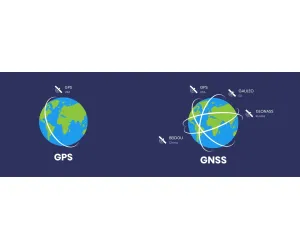Why Indoor GPS Tracking Falls Short
Since its launch in 1993, the U.S. Global Positioning System (GPS) has revolutionized asset tracking. Today, multiple Global Navigation Satellite Systems (GNSS) exist, working through receivers that calculate positions based on satellite signals.
However, GPS requires at least four satellite signals to determine an accurate location—three for triangulation and one for time calibration. Physical barriers like concrete, metal, and other dense materials block or weaken these signals, making GPS unreliable indoors. Warehouses, hospitals, and multi-story buildings present major challenges for traditional GPS-based tracking.
When GPS fails, businesses must adopt specialized indoor asset tracking solutions, such as WiFi positioning, to effectively monitor their assets.
Indoor Asset Tracking Solutions
Indoor asset tracking relies on WiFi, Bluetooth®, and other technologies to provide accurate location data within enclosed environments, overcoming the limitations of GPS.
Why Is Indoor Asset Tracking Essential?
Facilities such as warehouses, hospitals, and manufacturing plants contain high-value assets that require efficient management. Tracking these assets provides:
✅ Operational Efficiency – Quickly locate equipment, minimize downtime, and boost productivity.
✅ Asset Security – Prevent loss or theft by ensuring assets are always accounted for.
✅ Streamlined Processes – Improve inventory management and reduce the time spent searching for misplaced items.
Use Cases for Indoor Asset Tracking
Hospitals
Hospitals rely on asset tracking to keep critical equipment like wheelchairs, infusion pumps, and beds readily available. Real-time monitoring helps reduce search times, improve utilization, and enhance patient care. WiFi positioning systems enable seamless tracking across multiple floors and departments.
Warehouses
In warehouse environments, asset tracking optimizes storage and logistics by monitoring pallets, forklifts, and inventory. This reduces misplacements, streamlines workflows, and accelerates order fulfillment—all without requiring costly hardware.
Factories
Manufacturers use indoor tracking to ensure tools and machinery are always in the right place. A WiFi-based system helps track equipment across large facilities, reducing production delays caused by missing tools and improving overall operational efficiency.
WiFi Positioning System (WPS)
A WiFi positioning system (WPS) leverages existing WiFi networks to locate assets. Instead of satellite signals, it scans for nearby WiFi access points and analyzes signal strength to determine an asset’s position.
How Does WiFi Positioning Work?
✔ Triangulation: Uses signal strength from multiple WiFi networks to pinpoint an asset’s location. The more networks available, the higher the accuracy.
✔ No Network Connection Required: WPS only scans for networks, making deployment simple and efficient.
✔ Infrastructure Dependent: Works best in areas with dense WiFi coverage, such as urban environments.
Enhancing WiFi Positioning Accuracy
???? Add Beacons: Small devices that provide additional location data to improve accuracy and coverage.
???? Deploy in High-Density Areas: More WiFi signals result in better positioning accuracy.
Key Benefits of Indoor Asset Tracking
✔ Real-Time Visibility – Quickly locate assets in hospitals, warehouses, and offices.
✔ Cost-Effective – Uses existing WiFi infrastructure, eliminating the need for expensive proprietary hardware.
✔ Efficiency Boost – Automates tracking, reducing manual effort and improving productivity.
What Is a WiFi GPS Tracker?
A WiFi GPS tracker is a hybrid device that combines GPS and WiFi technologies, enabling seamless tracking across both indoor and outdoor environments.
Hybrid Tracking Solutions
Hybrid tracking offers capabilities to ensure continuous visibility in both indoor and outdoor settings.
How It Works
✅ GNSS Scanning Technology – Uses GNSS scanning rather than traditional GPS modules, reducing power consumption for long-term tracking.
✅ WiFi Positioning – Leverages WiFi AP MAC address scanning for accurate indoor tracking.
✅ Hybrid Functionality – Seamlessly transitions between GPS and WiFi tracking as assets move between environments.
Why Choose Hybrid tracking?
✔ Versatile: Ideal for businesses with both indoor and outdoor tracking needs, such as hospitals, warehouses, and logistics companies.
✔ Cost-Effective: Optimized for long battery life—devices can run for over 10 years on replaceable batteries.
✔ Seamless Asset Visibility: Eliminates blind spots, ensuring assets are tracked wherever they go.




